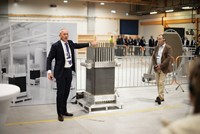Advertisement
Grab your lab coat. Let's get started
Welcome!
Welcome!
Create an account below to get 6 C&EN articles per month, receive newsletters and more - all free.
It seems this is your first time logging in online. Please enter the following information to continue.
As an ACS member you automatically get access to this site. All we need is few more details to create your reading experience.
Not you? Sign in with a different account.
Not you? Sign in with a different account.
ERROR 1
ERROR 1
ERROR 2
ERROR 2
ERROR 2
ERROR 2
ERROR 2
Password and Confirm password must match.
If you have an ACS member number, please enter it here so we can link this account to your membership. (optional)
ERROR 2
ACS values your privacy. By submitting your information, you are gaining access to C&EN and subscribing to our weekly newsletter. We use the information you provide to make your reading experience better, and we will never sell your data to third party members.
Business
Evonik, AkzoNobel, and Shell pursue hydrogen from electrolysis
The three European firms are initiating green hydrogen technology partnerships
by Alex Scott
January 24, 2018
| A version of this story appeared in
Volume 96, Issue 5

Three separate European groups plan to build electrolysis plants that will use renewable energy to split water and make hydrogen. The groups say they are motivated by the opportunity to make production of hydrogen, now derived mostly via natural gas reforming, more sustainable.
The chemical maker Evonik Industries has teamed up with Siemens in a two-year “artificial photosynthesis” research project that will use electrolysis powered by renewable electricity to convert water and carbon dioxide into hydrogen and carbon monoxide. In a subsequent step, micro-organisms convert the carbon monoxide and hydrogen into specialty chemicals.
The firms say they will bring a test plant on stream in Marl, Germany, by 2021. A second phase will likely involve building a commercial plant with a capacity of up to 20,000 metric tons per year, Evonik says. The initial project is set to receive $3.5 million from Germany’s Federal Ministry of Education & Research.
A joint team of 20 scientists will participate, with Evonik contributing fermentation expertise and Siemens providing capability in electrolysis.
Meanwhile, AkzoNobel has partnered with Gasunie New Energy, a Dutch gas distribution firm, to use electrolysis to convert renewable electricity and water into hydrogen. The partners plan to build in the Netherlands what they say will be Europe’s largest such facility, featuring a 20 MW water electrolysis unit that produces about 3,000 metric tons per year of hydrogen.
AkzoNobel says it will make a final decision on the project in 2019, with a view to building the facility in the early 2020s. The firm’s long-term goal is to produce hydrogen sustainably for the wholesale market.
Separately, Shell has joined a consortium that includes U.K. proton exchange membrane maker ITM Power to build a 10 MW water electrolysis unit that makes 1,300 metric tons of hydrogen per year for its refinery in Wesseling, Germany.
The facility, which will feature a proton exchange membrane, is due to open in 2020. The European Commission will pay half of the project’s $25 million cost. Initial capacity will meet less than 1% of the refinery’s hydrogen requirements, although expansion is an option, Shell says.
CORRECTION: This story was updated on Jan. 25, 2018, to fix a typographical error in the term proton exchange membrane.



Join the conversation
Contact the reporter
Submit a Letter to the Editor for publication
Engage with us on Twitter